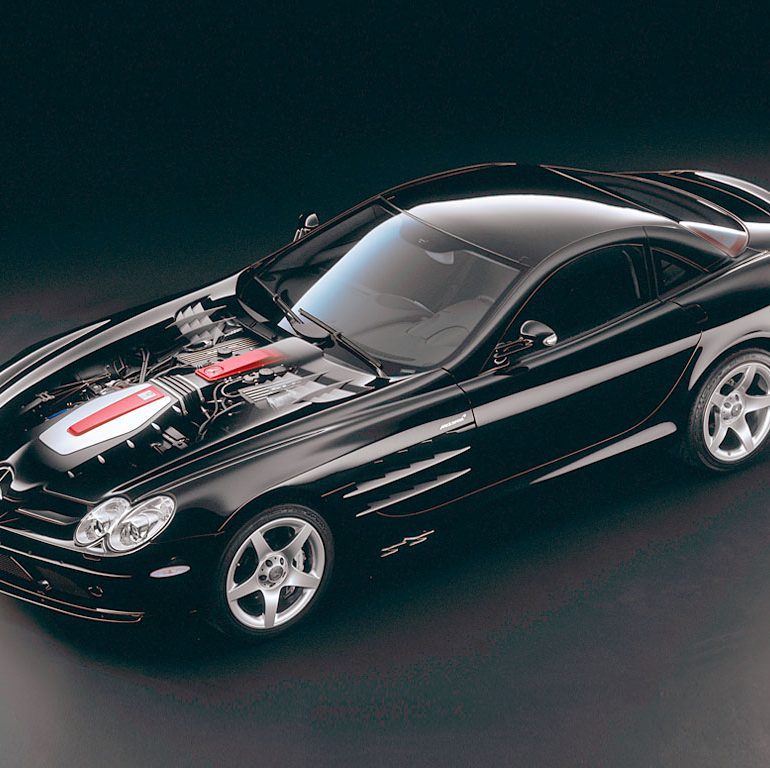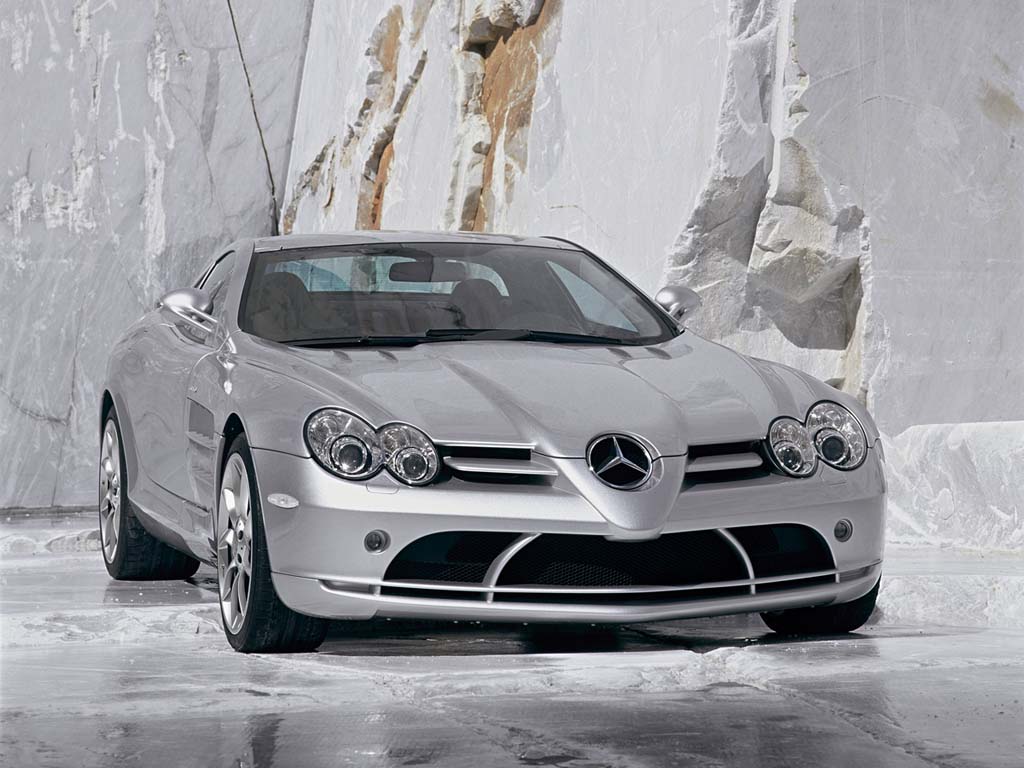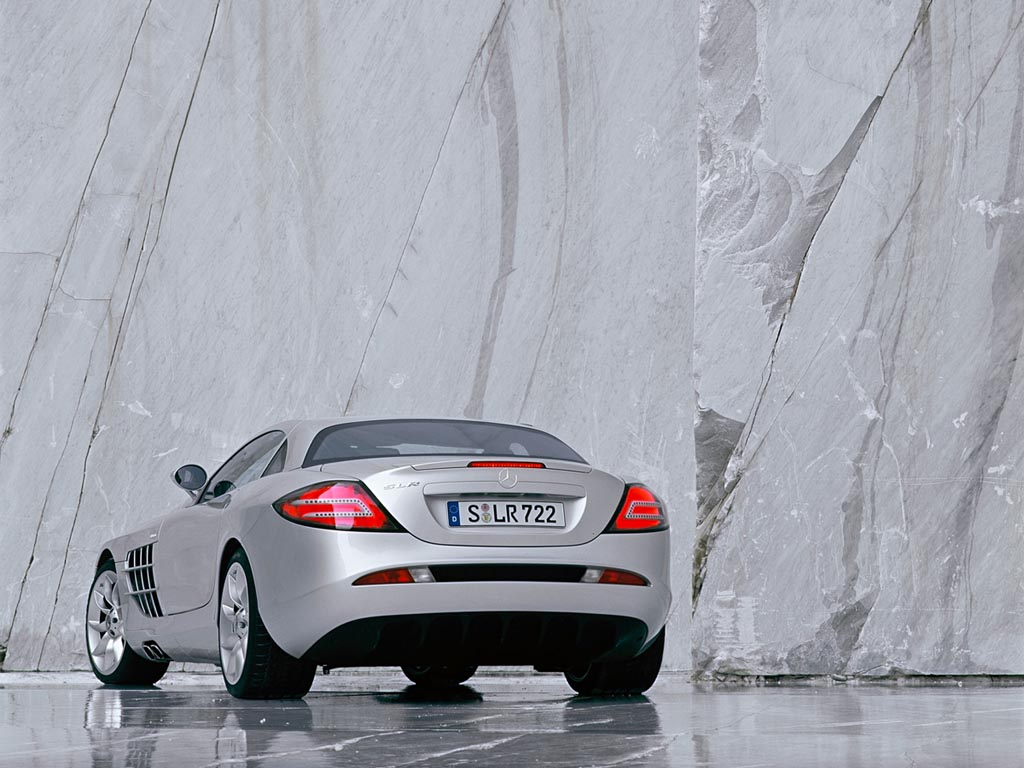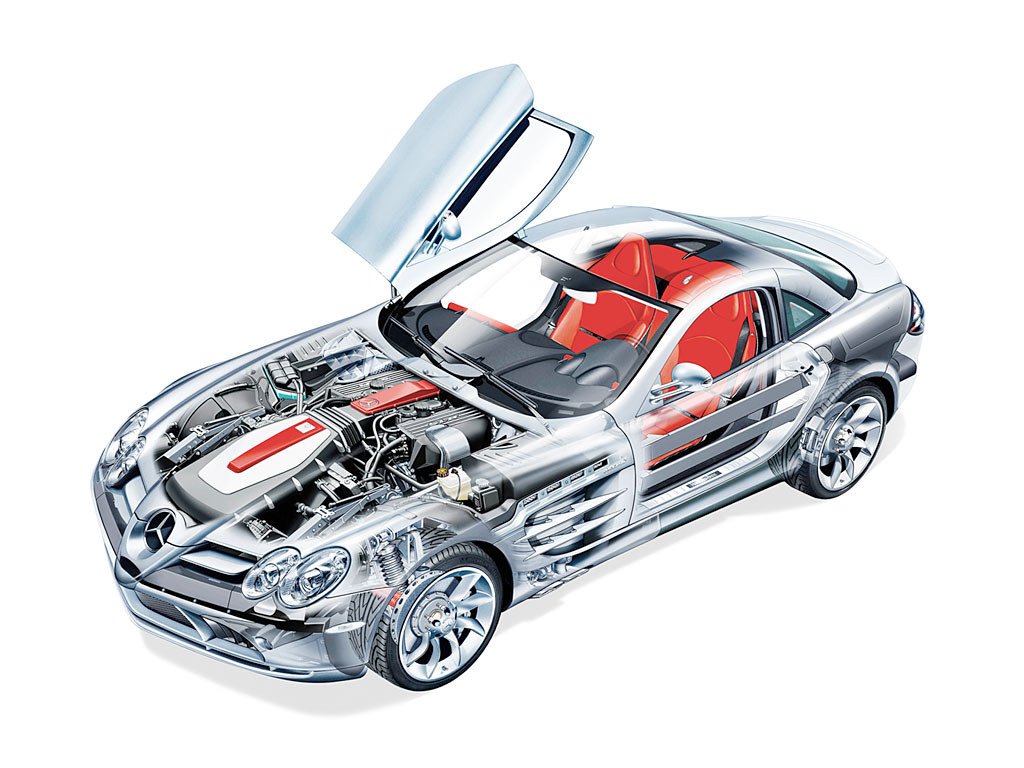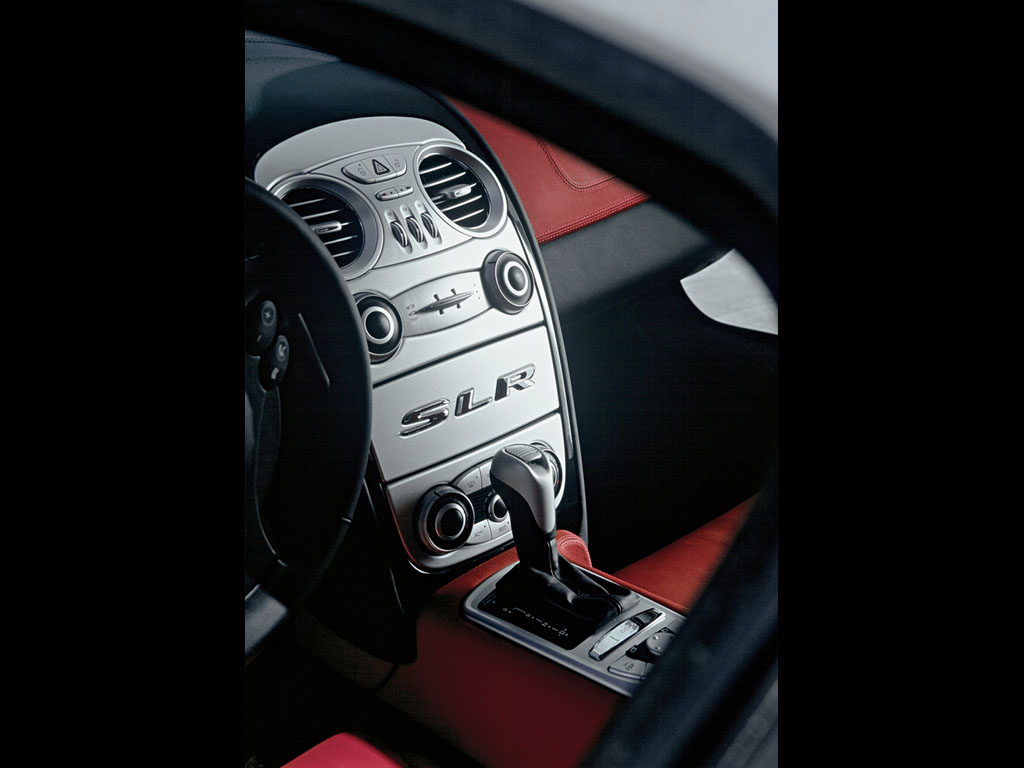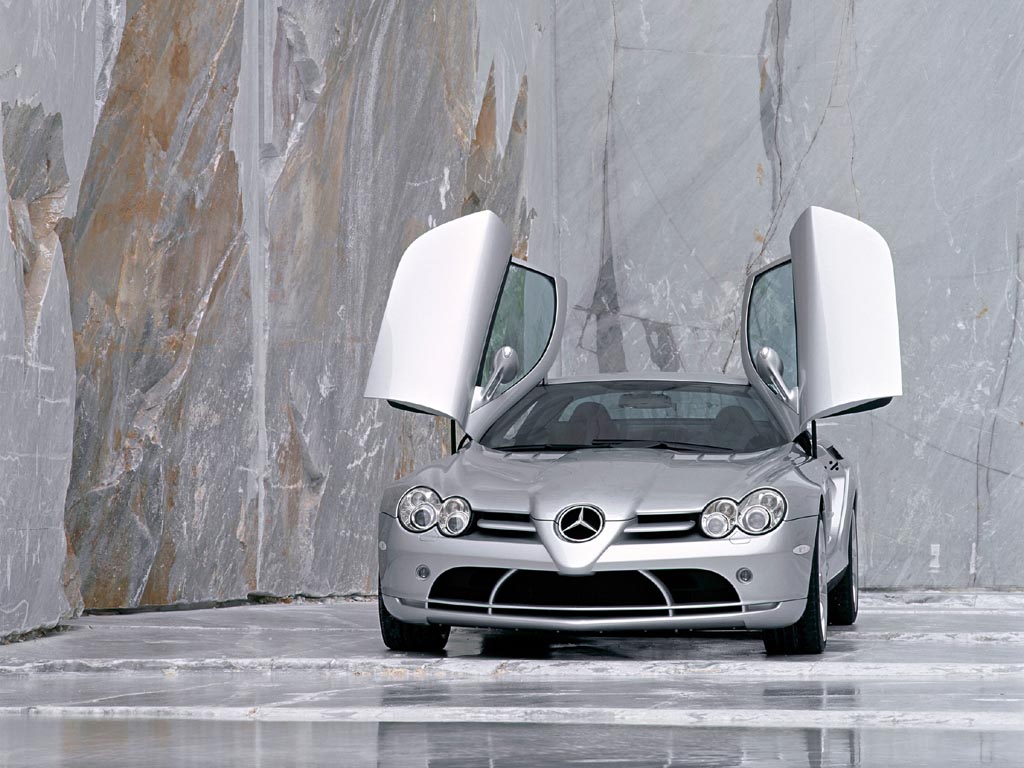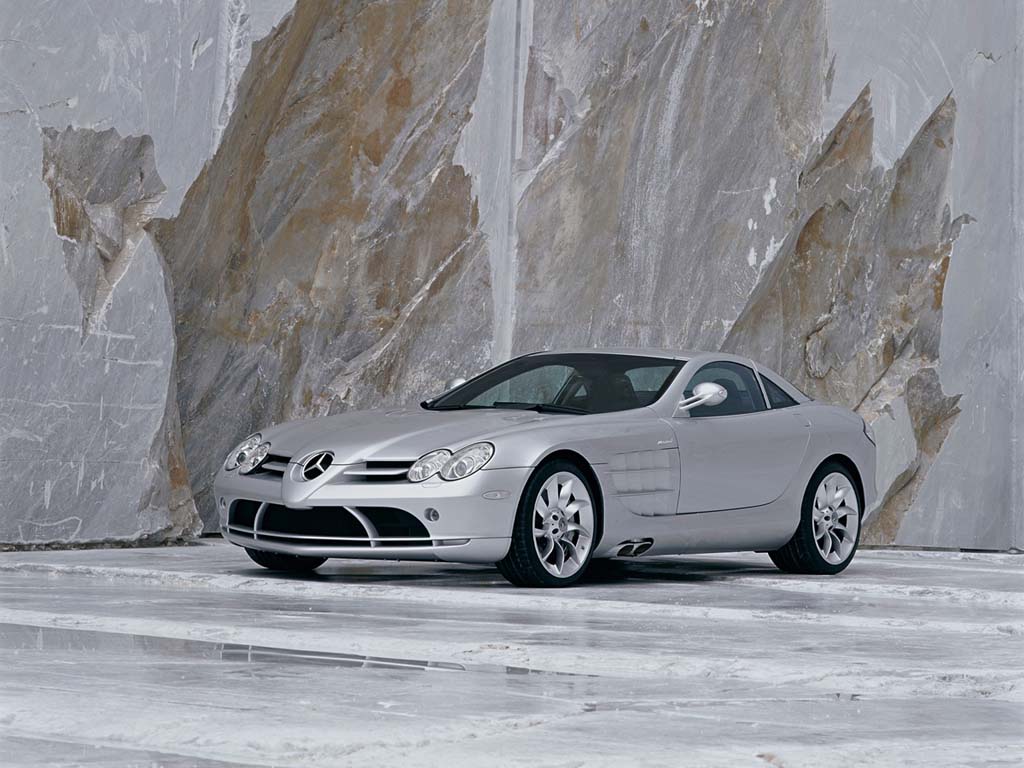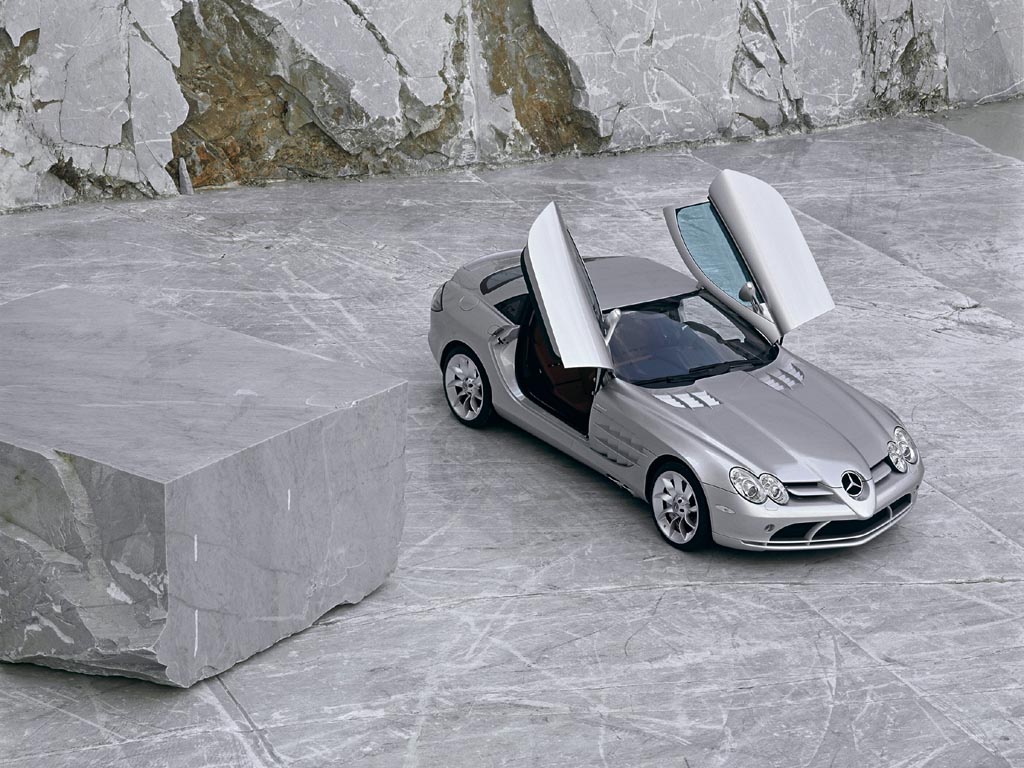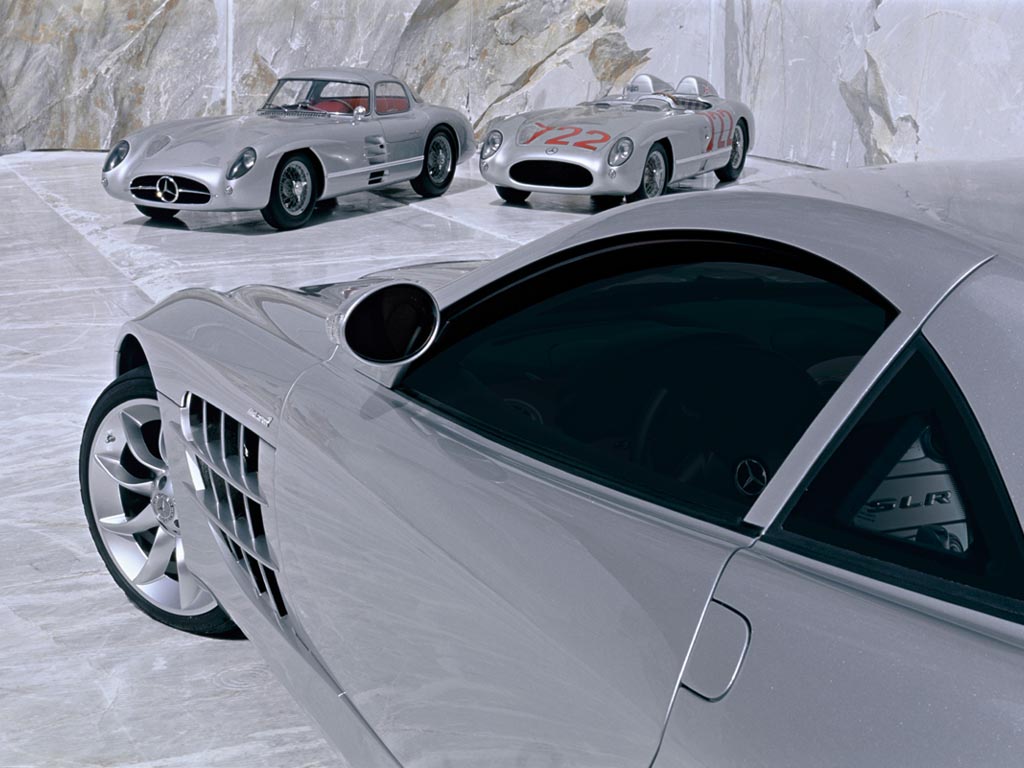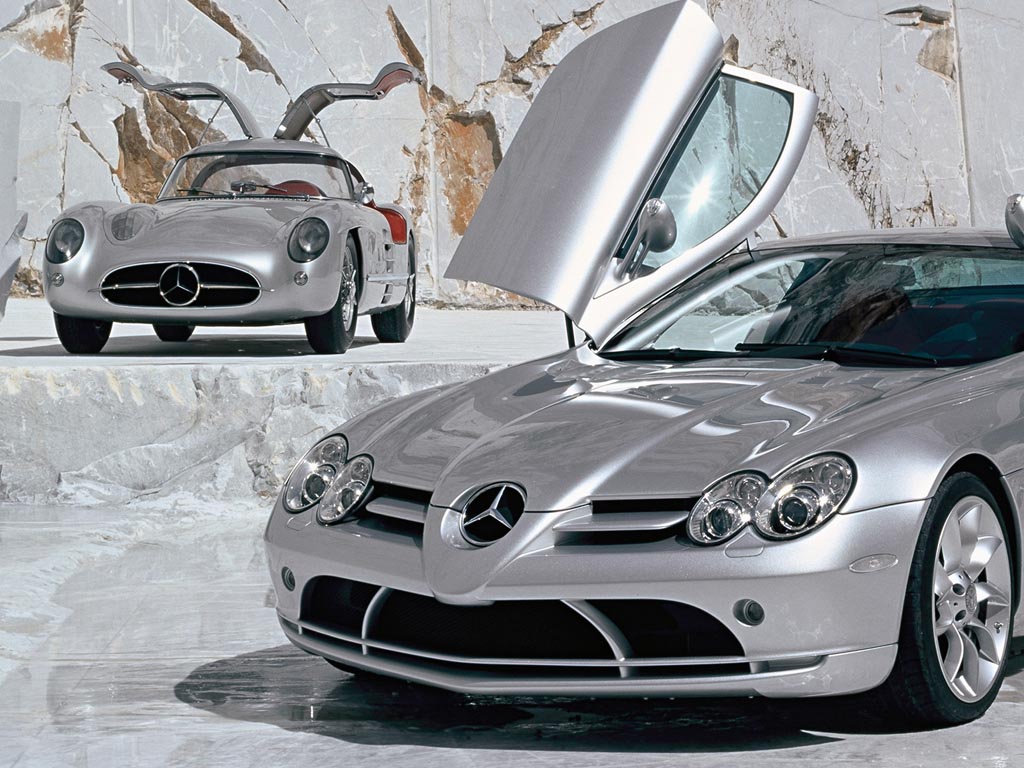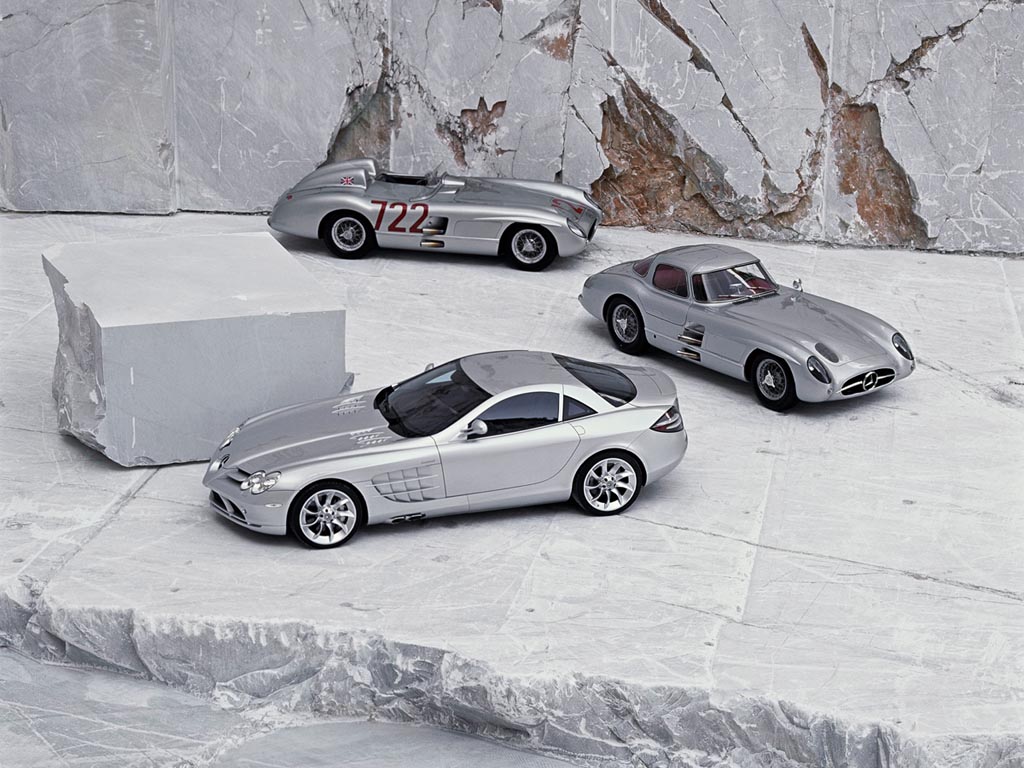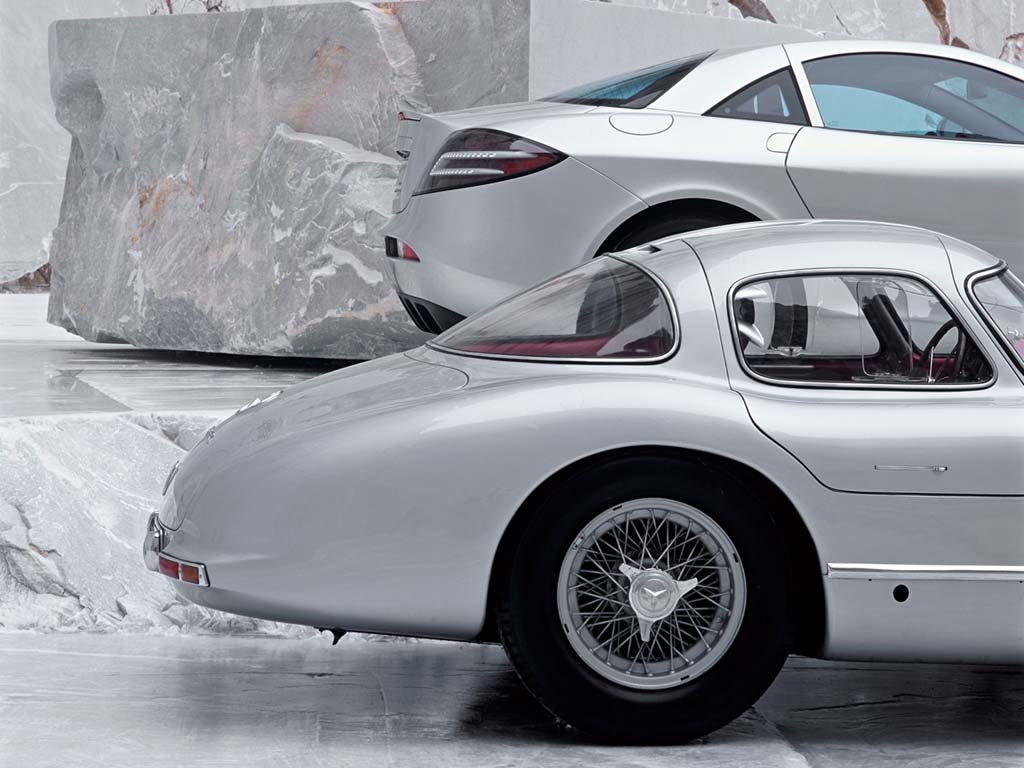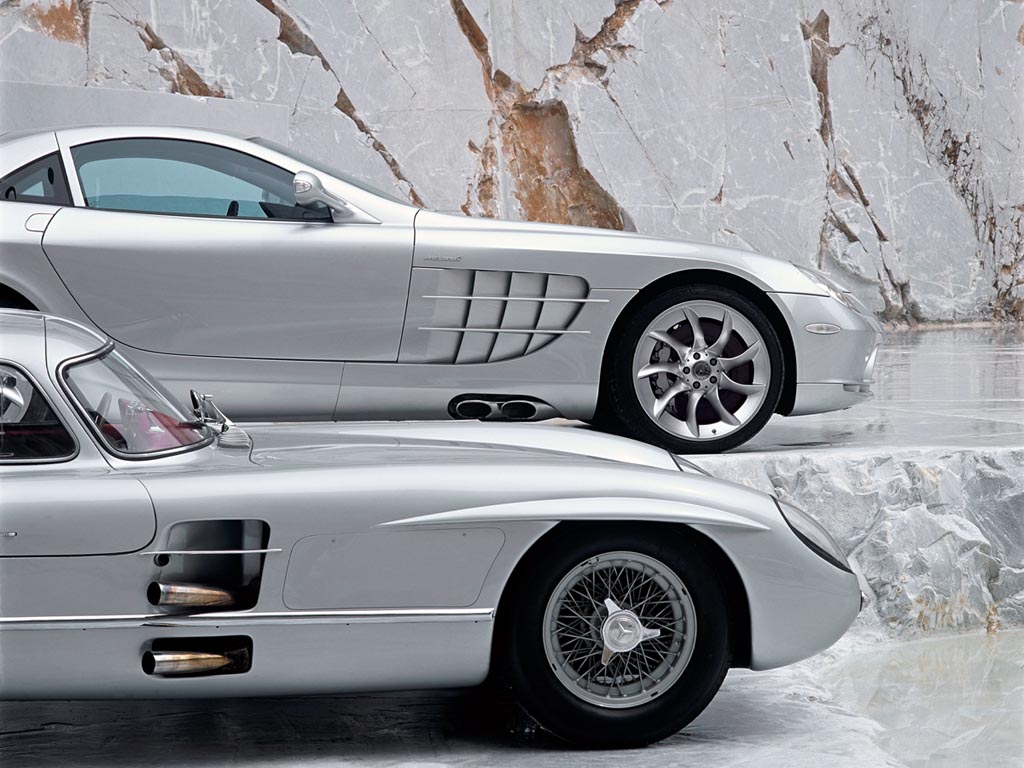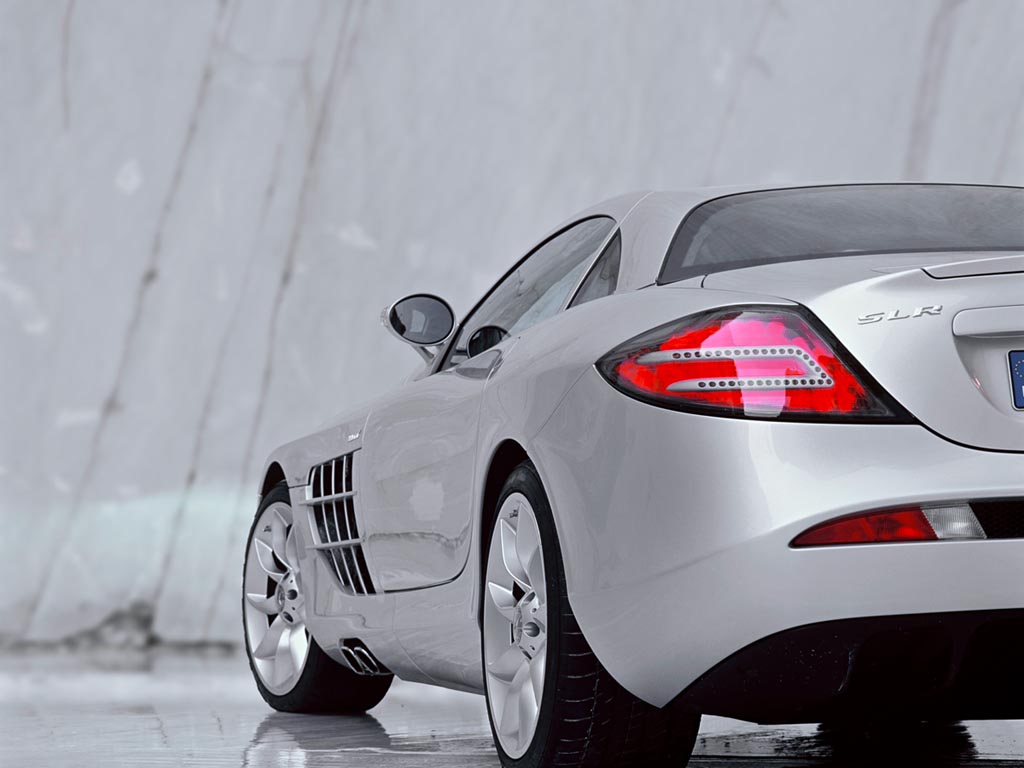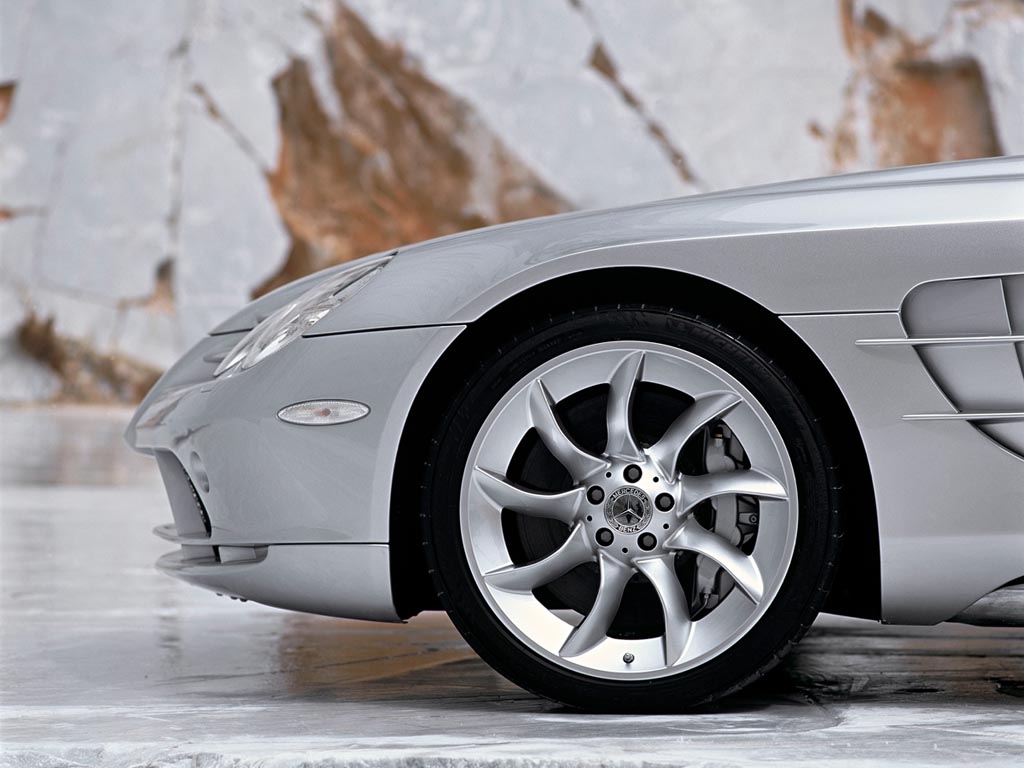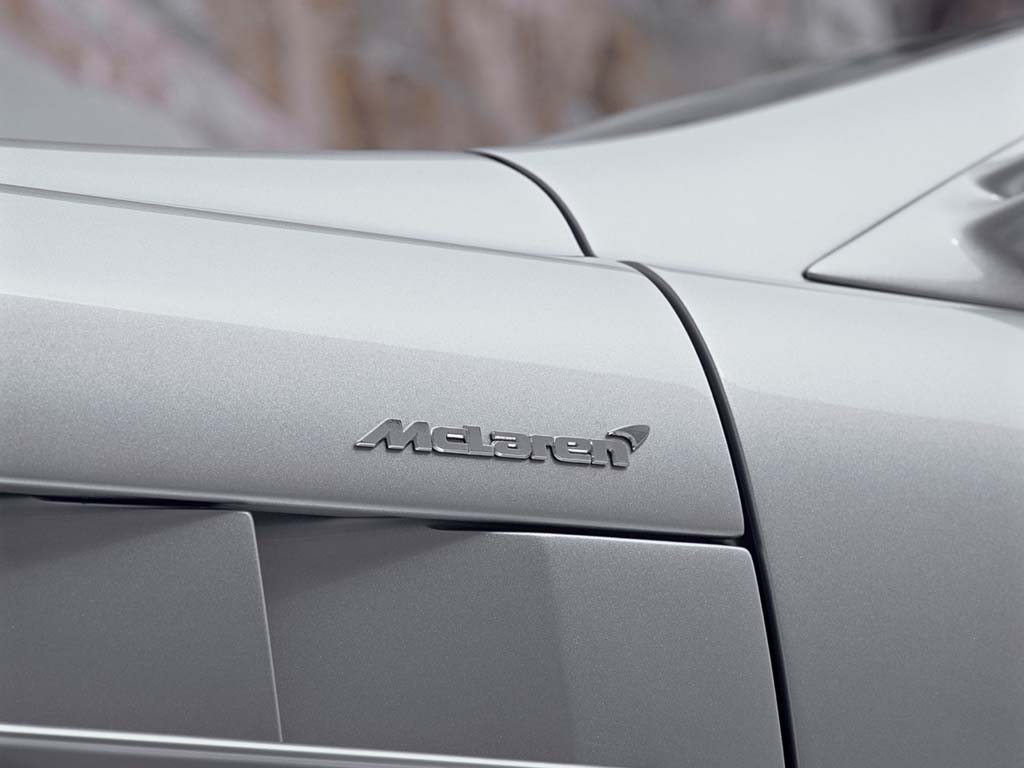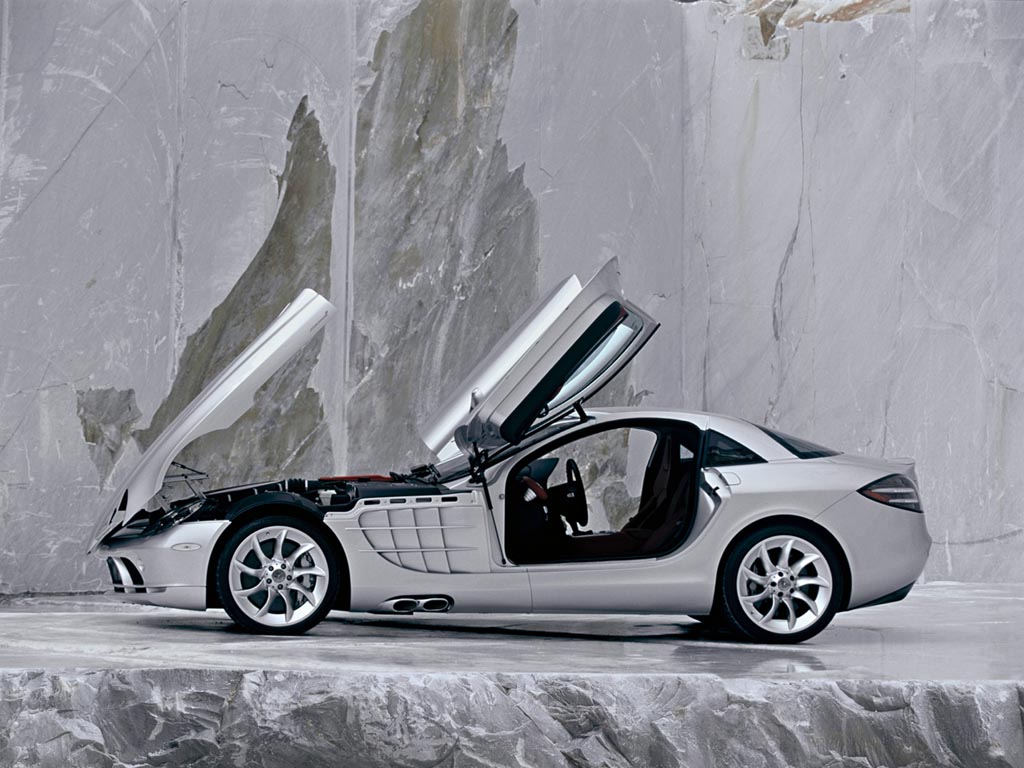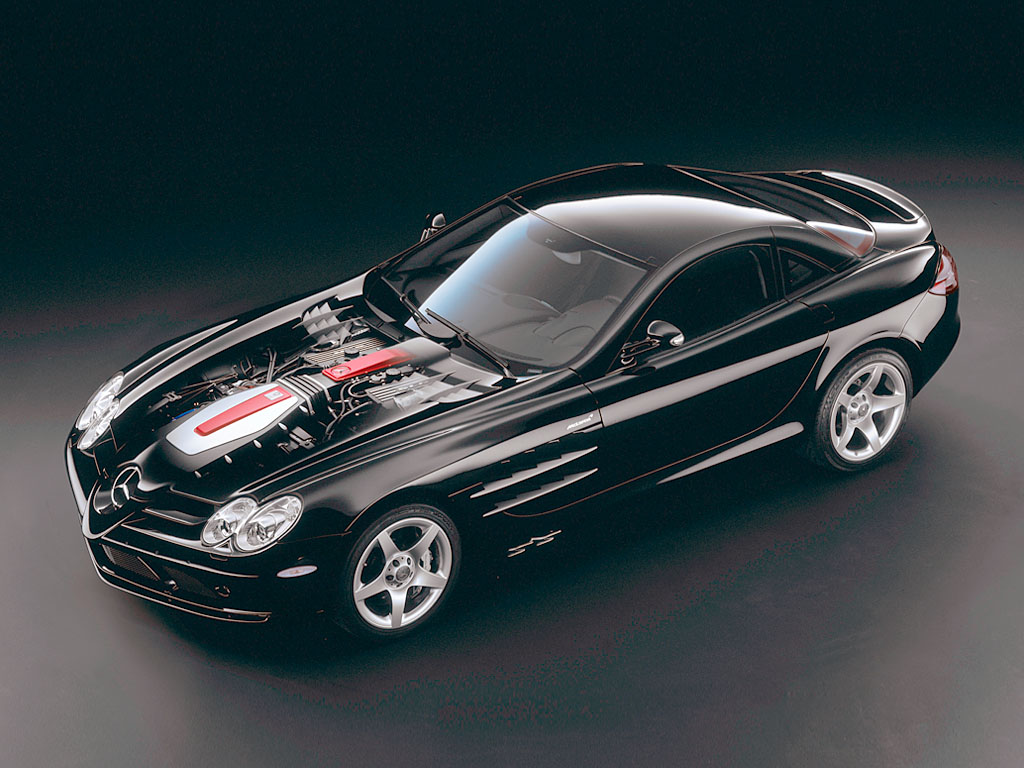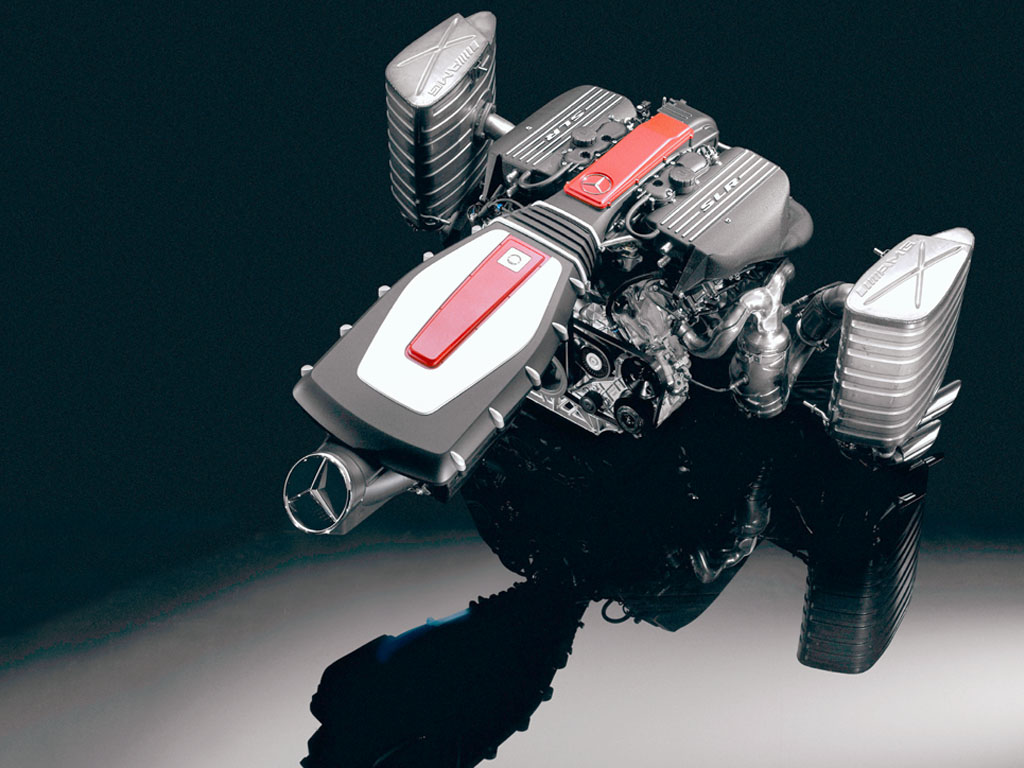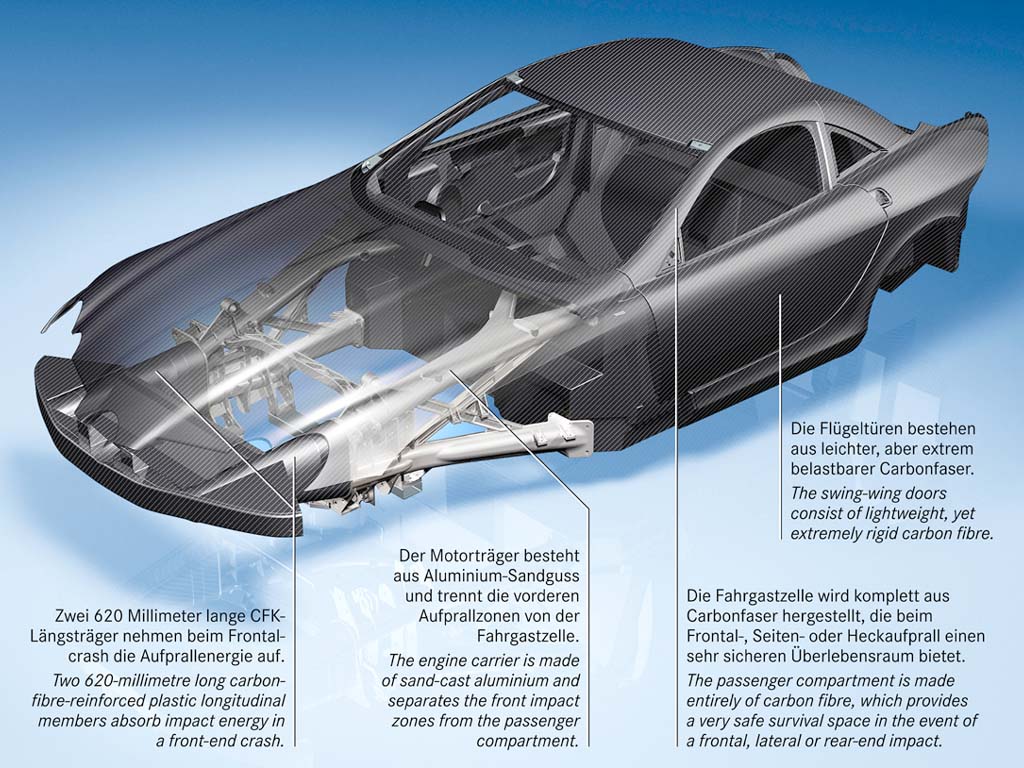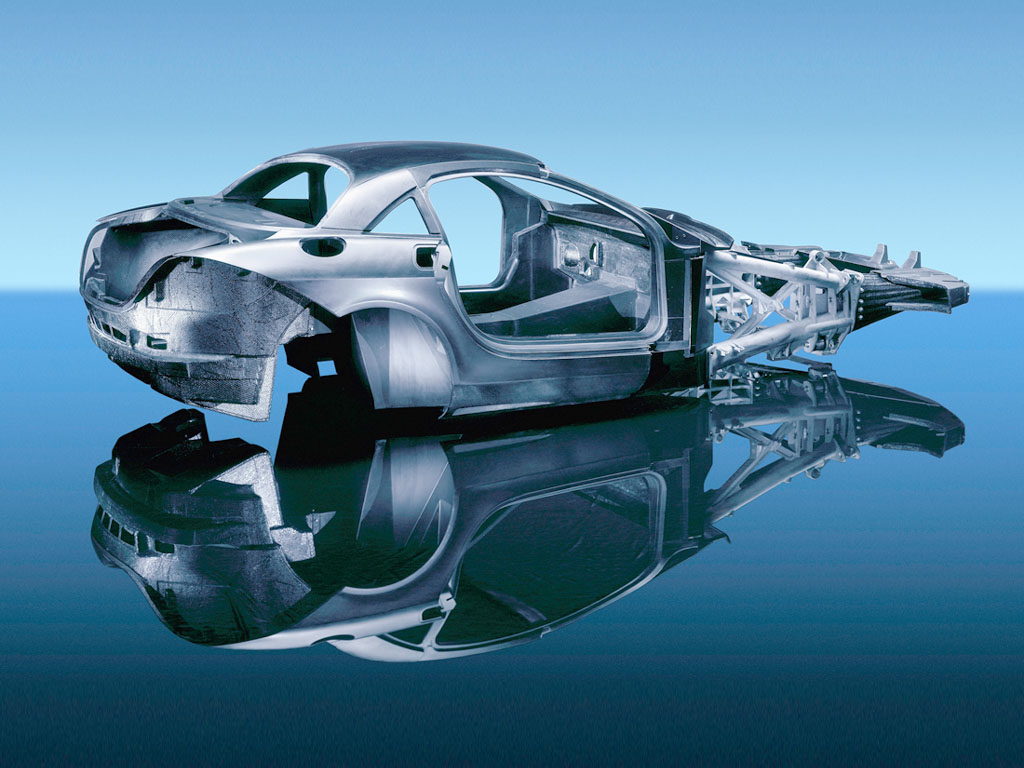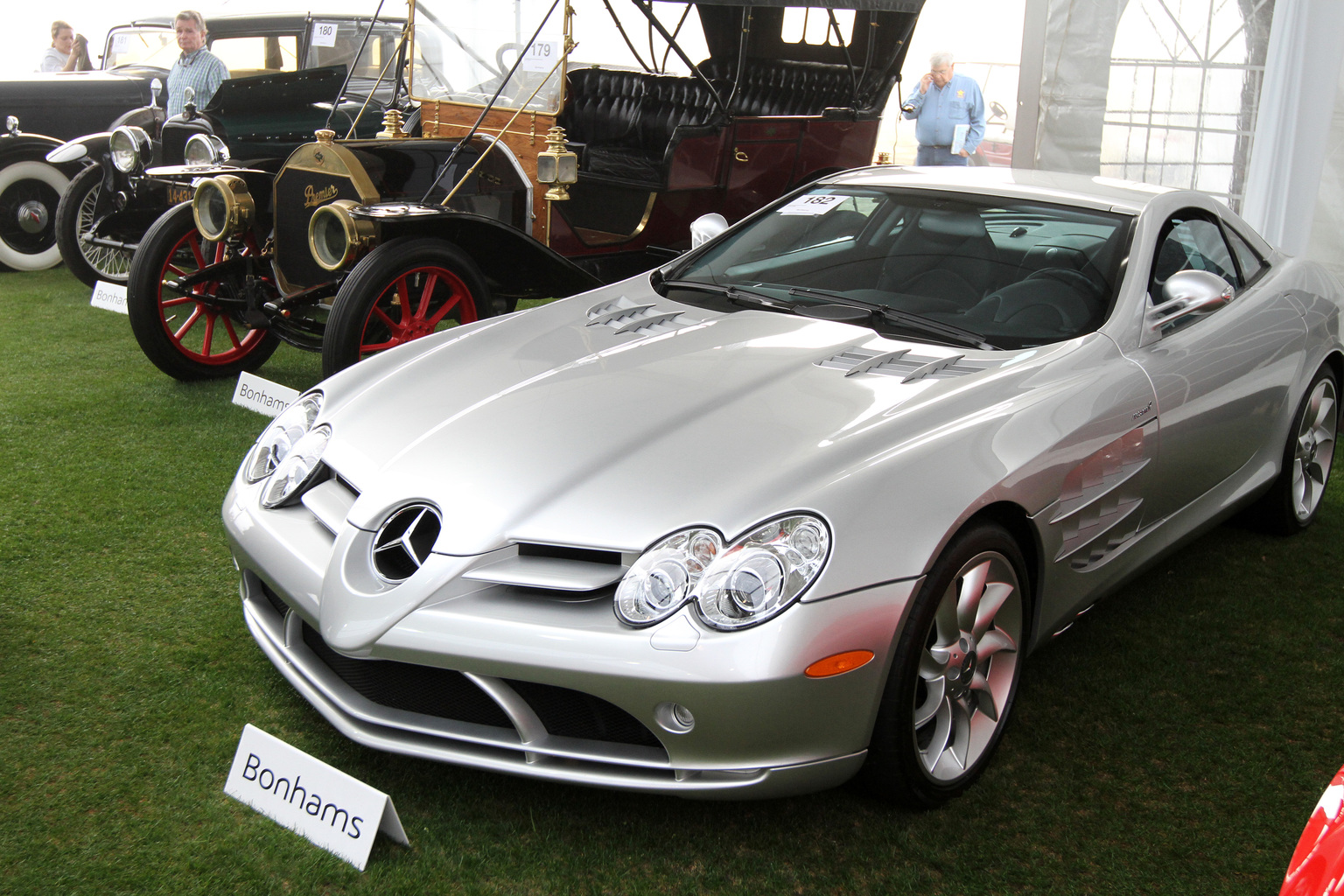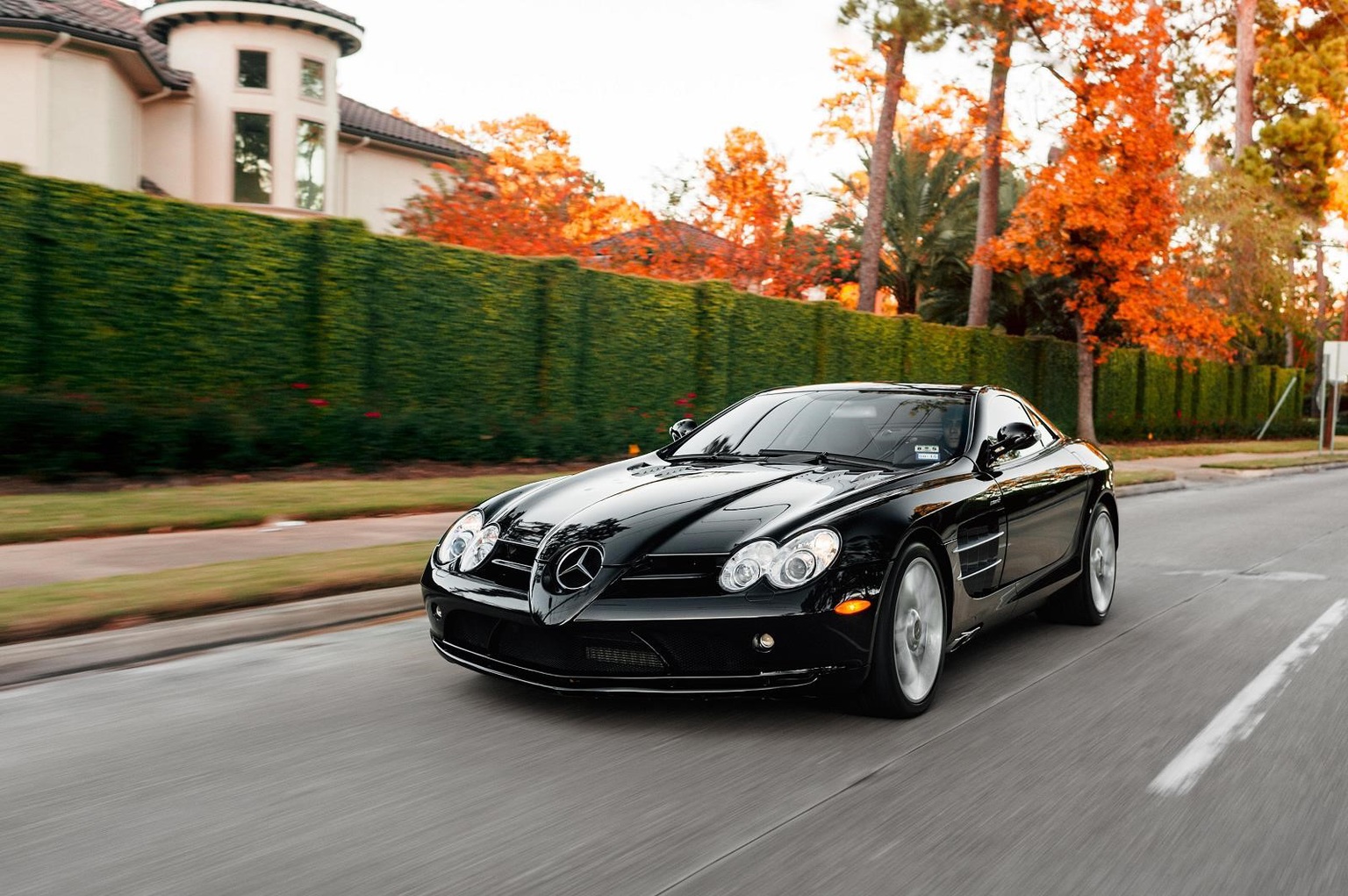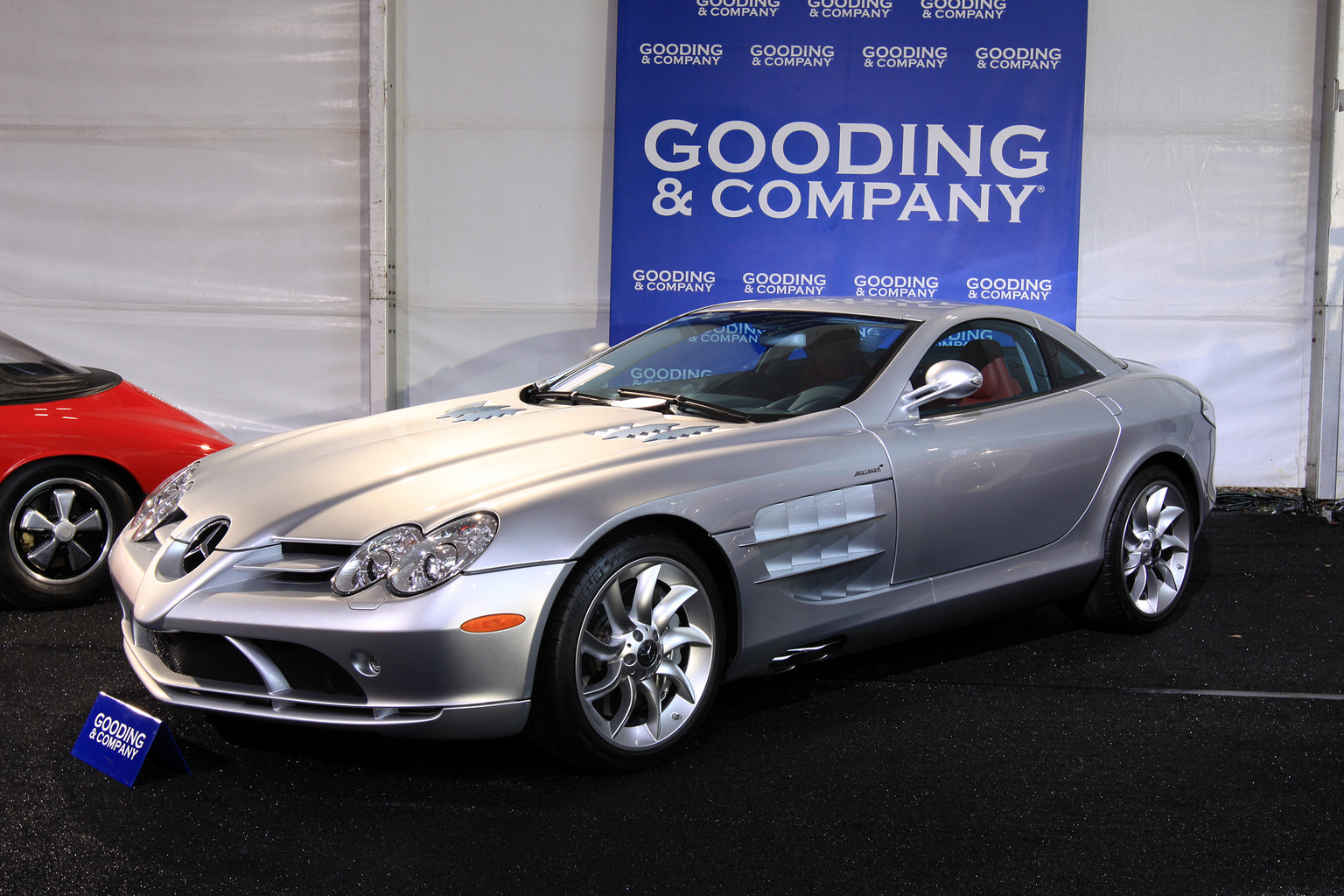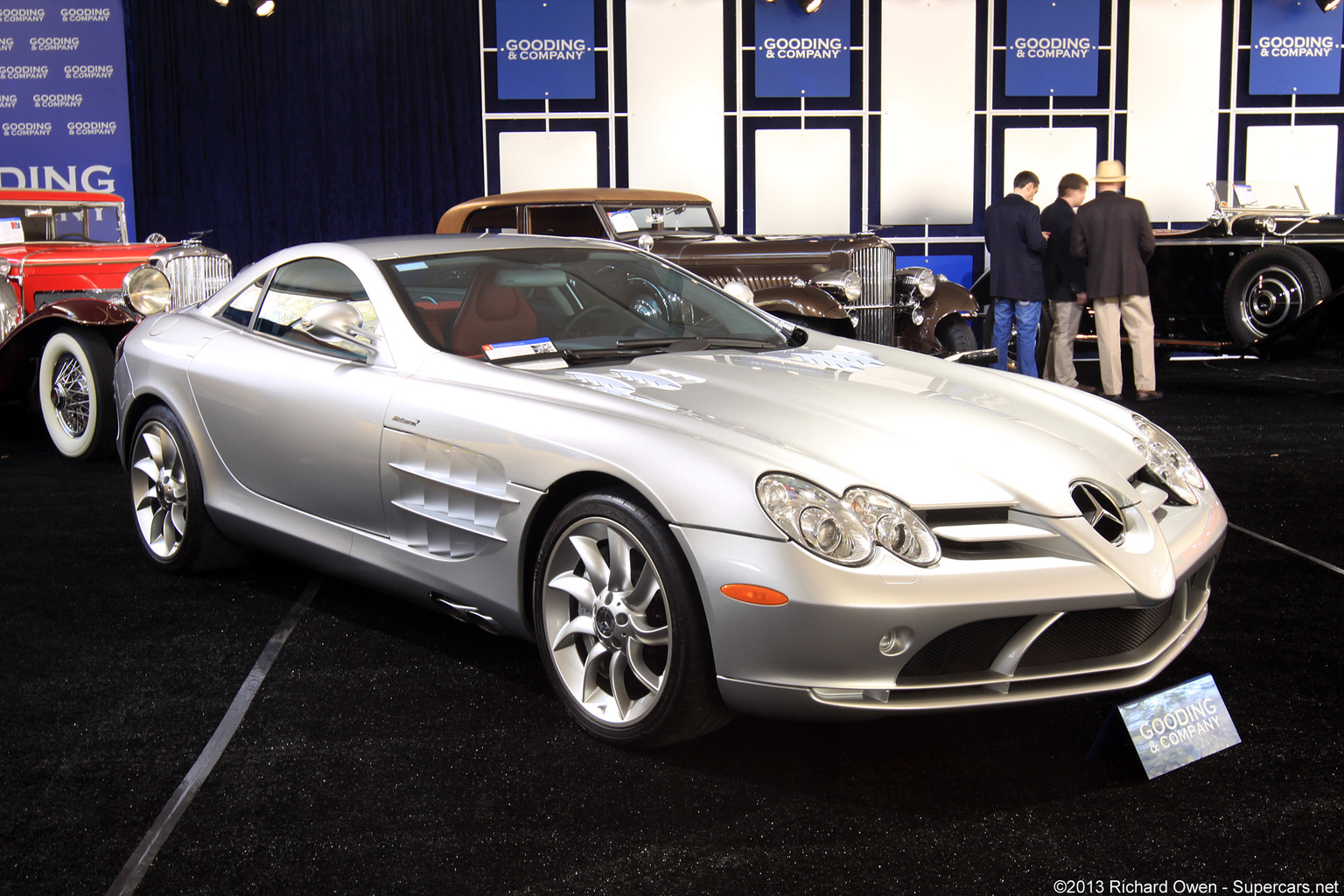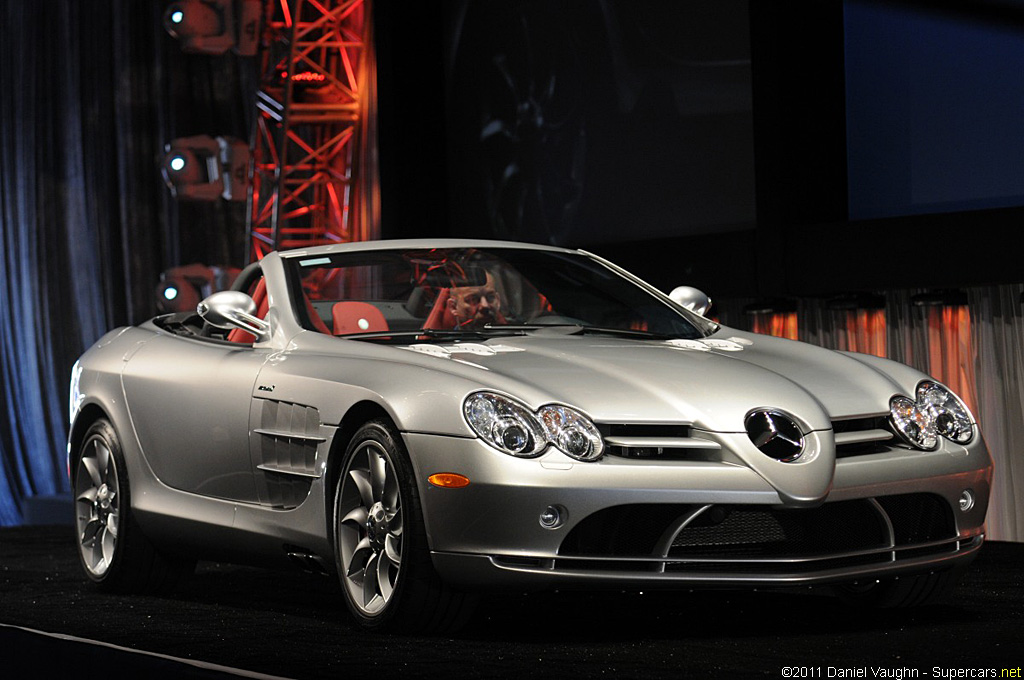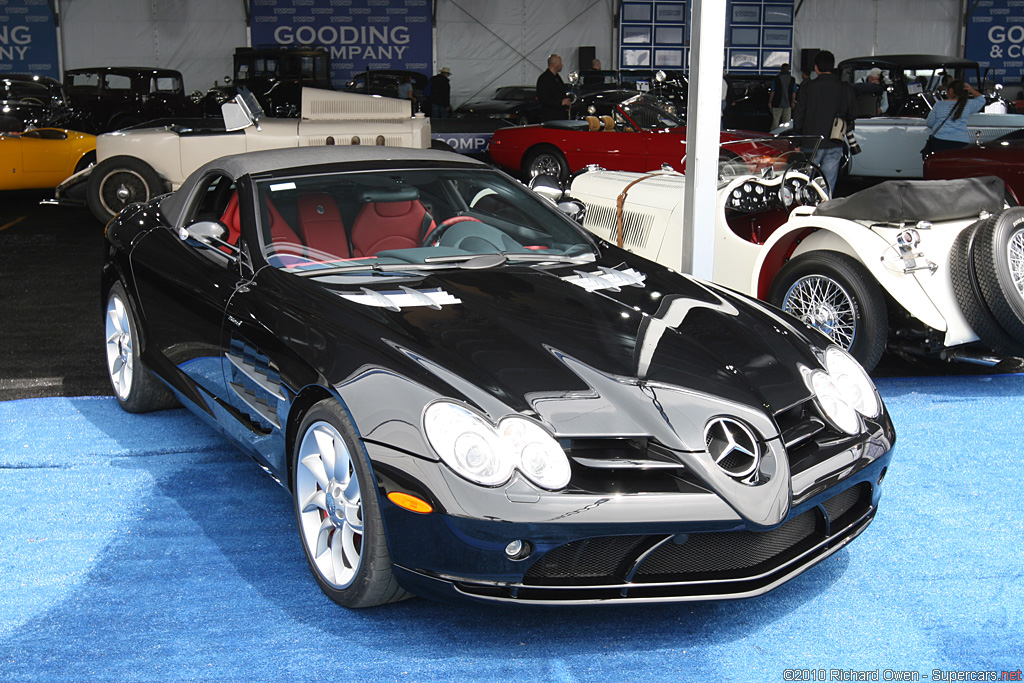2003→2009 Mercedes-Benz SLR McLaren
The Mercedes-Benz SLR McLaren revives the glorious tradition of the SLR and marks the reawakening of Mercedes-Benz’ passion for super sports cars. It is a passion which can be traced way back through automotive history and which was demon-strated with the Uhlenhaut Coupe. A contemporary interpretation of stylistic elements lifted from the original SLR and design details taken from the 2003 Formula 1 Silver Arrows allow the 21st-century SLR to form a bridge between the past and the future, bringing cutting-edge motorsport technology to the road, just as the inspirational SLR Coupe did in 1955.
The new super sports car allows Mercedes-Benz and its Formula 1 partner McLaren to showcase their collective experience in the development, construction and production of high-performance sports cars. This combination of knowledge and expertise is evident not only in the host of pioneering developments, impressive performance figures and superior driving characteristics of the SLR, but also in the extremely high levels of safety and practicality which it offers. These attributes come together to form the basis for an automobile with a very special charisma – an impressive synthesis of Mercedes tradition and innovation in every respect.
Just like its legendary predecessor of 1955, this SLR incorporates new technological developments which are ahead of their time. For evidence, simply take a glance under the bonnet at the Mercedes-AMG V8 powerplant. With its 5.5-litre displacement and screw-type compressor, the engine develops a peak output of 460 kW/626 hp and delivers its maximum torque of 780 Newtonmetres from 3250 rpm – a figure which remains constant across a broad engine speed range of up to 5000 rpm. With this kind of power under the bonnet, the Mercedes-Benz SLR McLaren delivers performance figures which are among the best in its class: this high-performance sports car takes just 3.8 seconds to sprint from 0 to 100 km/h, it passes the 200 km/h mark after 10.6 seconds, and from a standing start it takes just 28.8 seconds to reach 300 km/h. The two-seater has a top speed of 207 mph (334 km/h).
In the interests of optimum weight distribution, optimum dynamic handling and high stability on braking, the Mercedes-Benz SLR McLaren has a front mid-engined design. The V8 powerplant is mounted on a robust aluminium frame and has a low installation position. Water-type charge-air cooling, three valves per cylinder, dry sump lubrication and four metal catalytic converters are further special features of this powerful engine – an engine which already meets stringent EU 4 exhaust gas regulations which are not due to come into force until 2005.
Engine & Transmission
When developing the powerplant, the AMG engineers applied both the expertise they had acquired during their three-decade involvement in motorsport and the stringent standards of the Mercedes-Benz brand. After an extensive concept phase, they decided in favour of an 8-cylinder design with a 5.5-litre displacement, a cylinder angle of 90 degrees, a screw-type compressor and a crankshaft supported by five bearings.
The result is impressive: from a mere 1500 rpm, the SLR powerplant delivers torque of over 600 Newtonmetres, rising to 700 Newtonmetres at 2000 rpm. The maximum of 780 Newtonmetres is available from 3250 rpm and remains constant in a broad engine speed range up to 5000 rpm As the figures indicate, the new SLR is endowed with what is currently one of the most powerful engines to be found in a series-produced roadgoing sports car.
The design of the powerplant’s oil cooling system is also based on experience gathered in the world of motor racing: a sophisticated dry sump lubrication system with an oil capacity of around eleven litres, combined with a five-stage oil suction pump and a two-stage oil pressure pump, ensures reliable lubrication under all on-road conditions. An important side effect of this technology is that, because of the dry sump lubrication, usually only used in motor racing vehicles, the engine is less tall and can therefore be installed at a lower level, allowing a low centre of gravity which benefits dynamic handling.
Following the usual practice at Mercedes-AMG, each SLR engine is manufactured by hand. In order to achieve the highest quality, the principle of ‘one man, one engine’ is applied. This means that each powerplant is the responsibility of one AMG engineer, who carries out the entire engine assembly process – from installing the crankshaft in the engine block and assembling the camshafts and the compressor to cabling.
Power from screw-type compressor
To ensure good cylinder charging, the engine has a mechanical compressor with two screw-type aluminium rotors which, in the interests of low friction losses, are Teflon-coated. The charger is so compact that the engine specialists were able to install it between the two cylinder banks of the V8 powerplant. Despite the space-saving design, its innovative technology allows a significantly higher charge pressure than conventional mechanical chargers because the two rotors achieve a top speed of around 23,000 revs per minute, forcing air into the air inlet of the 5.5-litre powerplant at a maximum pressure of 0.9 bar. This means that they compress around 1850 kilograms of air into the eight combustion chambers per hour – which is up to 30 percent more than the figure achieved by rival charging systems.
In order to ensure the greatest possible efficiency, the AMG engineers created an intelligent engine management system which regulates the operation of the screw-type compressor according to the engine speed and load. This means that the charger is only active when it is needed. Nevertheless, the system ensures that the maximum output is available as soon as the driver calls it up by stepping on the accelerator. When this occurs, the electronics of the engine management system trigger an electromagnetic coupling which immediately activates the compressor, which is powered by a separate poly-V-belt. Because the charger delivers its output in fractions of a second, even the most perceptive driver will not notice the phases without charger support. The charger system’s air recirculation flap, opened under partial load, helps reduce fuel consumption.
Manual transmission program for racing car-style shift times
The five-speed automatic transmission, developed by Mercedes-Benz and already successfully used in several exceptionally powerful models, is also designed for high performance. It has been specially optimised for very high torque and also offers the driver the option of choosing between different shift characteristics. The transmission transmits the engine power via a finely balanced aluminium and steel powertrain to the differential and the rear axle.
The Speedshift system, developed by Mercedes-AMG for particularly sporty driving, offers even more functions in the new SLR. The driver can decide, for example, whether to leave the shift work to the automatic transmission or to shift gears manually. He or she can also select the shift speed, determining how sporty the gearshifts are. A rotary switch in the centre console offers a choice of three settings: Manual, Comfort and Sport. The activated programme is indicated in the instrument cluster display by the letters M, C or S.
Bodyshell
When it comes to body and safety technology the new Mercedes-Benz SLR McLaren yet again lives up to its reputation as an innovative force among today’s Gran Turismos. High-tech materials from the field of aeronautical technology make their debut in a series-produced car here: carbon fibre is used for manufacturing the body, lending it its low weight and an exemplary rigidity and strength previously only achieved in Formula 1 race cars. The crash safety standards achieved using this innovative material are equally high.
Carbon fibre has been used to great effect in the aeronautical industry for some time. The rudder unit, vertical rudder, landing flaps and other parts of most airbuses are made from this material, in the development and series use of which the scientists at DaimlerChrysler Research played a significant role. Their expertise and the extensive experience of the Mercedes-Benz and McLaren experts in the field of race car design can now, for the first time, be seen in a series-produced car: the entire bodyshell and the doors and bonnet of the SLR are made from corrosion-resistant carbon fibre composite.
While offering the same strength as their steel or aluminium counterparts, carbon fibre components weigh up to 50 percent less than comparable steel components and up to 30 percent less than aluminium components. This makes carbon fibre composite the material of choice for manufacturing high-performance cars, because lower weight not only means lower fuel consumption but also outstanding transfer of power to the road. The lower the mass to be accelerated and braked, the better the agility. In fact, thanks to the extensive use of carbon fibre composites, the primary structure of the Mercedes-Benz SLR McLaren is around 30 percent lighter than the conventional steel construction of a comparable front mid-engined vehicle.
Carbon fibre composite offers significantly higher energy absorption
On top of this, the state-of-the-art lightweight material is also characterised by very good energy absorption. The figures here for carbon fibre composites are around four to five times higher than those for metal materials. Formula 1 constructors have been exploiting this quality for several years, manufacturing the crash structure of their race cars from carbon fibre composite. The result has been a significant fall in the number of serious injuries incurred in high-speed accidents in this top motorsportdiscipline.
The monocoque – or, to put it another way, the passenger cell – of the new Mercedes-Benz SLR McLaren is also made entirely from this high-tech material. In the event of a head-on, side-on or rearend collision, it offers the passengers a highly rigid and hence safe survival zone.
The first automated production of carbon fibre composite components
To date, carbon fibre composite components for racing cars and for the aeronautical and space industries have been manufactured by hand – a time-consuming process. The challenge for the Mercedes engineers was to use their experience in this field to develop automated methods of series production. To do this they divided the manufacturing process into separate stages, manufacturing of the preform being followed by impregnation with resin and hardening.
In order to allow extensive automation of the preform manufacturing process (the preform also being made from carbon fibre), the materials experts at Mercedes-Benz cast a glance at the work of their colleagues in the textile industry and adapted traditional manufacturing methods used in this sector, such as sewing, knitting, weaving and braiding, for the processing of high-performance carbon fibres.
To take an example, the web of the SLR’s longitudinal members is formed from several layers of carbon fibre placed on top of one another and sewed together by machine. Once the piece has been cut to shape and the ends folded up to form a double T profile, the web blank is inserted in a polystyrene braiding core. This core element is clamped into a specially developed braiding machine, which braids together the longitudinal members from 25,000 extremely fine, individual carbon filaments, these being unwound simultaneously from 48 reels. This technology allows the fibre material to be braided around the core at a precisely calculated angle to create the required contour. Several layers are even laid on top of one another in certain areas, depending on the required thickness. An innovative method was developed for this process too.
In a further manufacturing process, a computer-controlled tufting machine joins the inner web to the braid of the longitudinal member. The braid core is removed and the preform of the longitudinal member is cut to the correct size. The preform is then injected with resin. Several, now patented, solutions had to be developed and tested in order to ensure short cycle times and high repeat precision for this manufacturing process – crucial qualities in series production. The manufacture of the complex fibre struc-ture of the longitudinal members using a braiding machine requires a cycle time of just twelve minutes, which illustrates the unit potential that this innovative manufacturing technology offers.
Suspension
Highly developed motor racing technology, high-performance control systems and cutting-edge materials – a unique combination which propels the Mercedes-Benz SLR McLaren into a new dimension in sports car dynamics, helping it to achieve top figures in three key areas: agility, active safety and comfort. In the process, the SLR suspension meets every criteria a discerning car driver would expect to find in a Gran Turismo with a Mercedes star.
The axle design bears the signature of experienced racing car developers, with double wishbone suspension at the front and rear. The lower struts are arranged so that, as the springs compress and when cornering at speed, the wheels have a negative camber. This ensures the best possible contact with the road in every situation. At the same time the axle technology prevents the front of the car from diving when braking heavily and the rear from diving when accelerating.
Aluminium was the key material for the developers of the new Mercedes-Benz SLR McLaren’s suspension. The wishbones are made from forged aluminium, while the wheel mounts are cast in aluminium. In addition to a whole series of other advantages over conventional steel designs, the lightweight nature of the material allows the suspension to react significantly faster and to respond more sensitively.
The relatively long wheelbase (at 2700 millimetres) also contributes to the SLR’s exemplary handling and makes itself noticed above all in the car’s exemplary directional stability, while the large track width, combined with the low centre of gravity, allows high cornering speeds.
Springing/damping combinations at the front and rear axle and an anti-roll bar at the front complete the suspension structure. The anti-roll bar is positioned above the front axle and – as in Formula 1 – is controlled via rocker arms. This means that it does not take up any installation space which could impair the smooth line of the underbody – a vital factor when it comes to the sports car’s outstanding aerodynamic properties.
The speed-sensitive rack-and-pinion power steering also corresponds with the in-telligent lightweight concept. In comparison with other steering systems, this design is characterised by a significantly lower weight. Thanks to its low installation position in front of the engine and the gear ratio of 12.6, the steering system re-sponds directly to the driver’s commands and carries them out with high precision. The three-spoke steering wheel has a diameter of 380 millimetres and is fitted with an electric motor which allows it to be positioned to suit the individual driver. It can be adjusted by 60 millimetres for reach, and the height of the steering wheel can be varied by 2.7 degrees
SBC and ESP
The electrohydraulic braking system, Sensotronic Brake Control, a milestone in car technology, forms part of the standard equipment of the Mercedes-Benz SLR McLaren. It processes data from various sensors regarding the current status of the vehicle and can use this to calculate and apportion the optimum brake pressure for each wheel at lightning speed. A high-pressure accumulator holds the brake fluid, which flows into the system at a pressure of 140 to 160 bar. This also optimises the function of the Electronic Stability Program (ESP), which keeps the SLR safely on track by applying targeted brake impulses to the individual wheels and/or reducing the engine torque. Here too SBC offers the advantage of higher dynamism and precision: thanks to even faster and even more finely metered brake impulses from the SBC high-pressure accumulator, ESP can stabilise a swerving vehicle comfortably at an early stage.
The coordination of this system with the Electronic Stability Program (ESP) was a particular challenge for the engineers of the high-performance sports car. Their aim was to adapt the dynamic handling control system to the vehicle’s distinctly sporty performance yet maintain the usual safety standards, achieving an ideal compromise between outstanding dynamic handling and exemplary directional stability. Here too SBC demonstrated its strengths, being able to deliver adequate braking power at lightning speed in every on-road situation, thanks to its sophisticated sensors and the high-pressure accumulator, making a key contribution to the precision handling of the SLR. It was therefore possible to allow a very sporty driving style with controlled side-slip angles in keeping with the character of the high-performance car without compromising active safety. On top of this, SBC significantly enhances active safety in critical situations.
Ceramic brake discs for top performance
Mercedes-Benz has optimised the outstanding properties of the Sensotronic Brake Control system in the new SLR with a braking system which also marks a technological high-point in a high-performance car: at the front and rear axle of the cutting-edge swing-wing door vehicle, brake discs made from fibre-reinforced ceramic ensure reliable deceleration. Their development is based on the one hand on the results of DaimlerChrysler materials research and on the other on Mercedes-AMG’s experience of high-tech brakes in touring cars and GT sport. Here Mercedes-Benz yet again underlines its leading role in the development of groundbreaking technologies for car production.
In manufacturing the brake discs, the carbon fibre, powdered carbon and resin are pressed into shape at high pressure and baked with a silicon infiltration at temperatures of around 1500 Celsius to form the ceramic. The advantages of this composite material are considerable: in addition to being characterised by an extremely sensitive response, the Mercedes-Benz SLR McLaren’s brake discs demonstrate a high temperature-resistance of up to 1000 Celsius, which produces a fade-resistance when braking at high speed never before achieved in a series-produced car. The result is brake power of up to 2000 hp.
Adaptable rear spoiler as airbrake
The outstanding performance of the SLR is also aided by the adaptable spoiler – known as the airbrake – in the boot lid. If the driver steps heavily on the brake pedal, the rear spoiler rises to an angle of 65 degrees, boosting the braking effect by producing greater aerodynamic drag. When braking from high speeds, it lends the SLR outstanding stability.
In most situations the electronics control the airbrake as required. However, the driver can also opt to take control of the adjustments using the switch in the centre console, manually
Story by DaimlerChrysler, edit by Supercars.net.
In Detail
| submitted by | Richard Owen |
| type | Series Production Car |
| production years | 2003 – 2009 |
| built at | Woking, Surrey, England |
| body stylist | Gorden Wagener |
| price $ | $ 455,000 |
| engine | 90 Degree AMG V8 w/Dry Sump |
| position | Front-Mid Longitudinal |
| aspiration | Screw-Type Compressor w/Two Charge-Air Coolers |
| valvetrain | SOHC, 3 Valves per Cyl |
| displacement | 5439 cc / 331.9 in³ |
| bore | 97 mm / 3.82 in |
| stroke | 92 mm / 3.62 in |
| compression | 8.8:1 |
| power | 466.8 kw / 626 bhp @ 6500 rpm |
| specific output | 115.09 bhp per litre |
| bhp/weight | 354.07 bhp per tonne |
| torque | 780 nm / 575.3 ft lbs @ -1750 rpm |
| body / frame | Carbon Fibre & Compsite Body & Chassis |
| front tires | 245/40 ZR 18 |
| rear tires | 295/35 ZR 18 |
| front brakes | Internally Vented Carbon Discs w/8-Piston Calipers, ESP, SBC |
| rear brakes | Solid Carbon Discs w/4-Piston Calipers, ESP, SBC |
| front wheels | F 45.7 x 22.9 cm / 18 x 9 in |
| rear wheels | R 45.7 x 29.2 cm / 18 x 11.5 in |
| steering | Rack & Pinion w/Speed Sensitive Assist |
| f suspension | Double Wishbones w/Anti-Roll Bar |
| r suspension | Doube wishbones |
| curb weight | 1768 kg / 3898 lbs |
| wheelbase | 2700 mm / 106.3 in |
| front track | 1638 mm / 64.5 in |
| rear track | 1569 mm / 61.8 in |
| length | 4656 mm / 183.3 in |
| width | 1908 mm / 75.1 in |
| height | 1261 mm / 49.6 in |
| transmission | 5-Speed Auto w/Speedshift System |
| gear ratios | 3.56:1, 2.19:1, 1.41:1, 1.00:1, 0.831:1 |
| top speed | ~334 kph / 207.5 mph |
| 0 – 60 mph | ~3.6 seconds |
| 0 – 100 mph | ~7.6 seconds |
| 0 – 1/4 mile | ~11.6 seconds |
Auction Sales History
2005 Mercedes-Benz SLR McLaren WDDAJ76F45M000157 – sold for $191,400 7,400 miles from new. Presented in nearly showroom fresh condition. One of only 45 SLRs produced in the 2004 calendar year. A perfect blend of Mercedes-Benz quality and McLaren/AMG performance. Offered with CARFAX report, books and service history.
Auction Source: The Amelia Island Auction 2015 by Bonhams
2005 Mercedes-Benz SLR McLaren WDDAJ76F45M000305 – sold for $209,000 ust two owners and less than 2,700 miles from new. Presented in nearly showroom fresh condition. Exceptionally powerful and luxurious supercar. A perfect blend of Mercedes-Benz quality and McLaren/AMG performance. Offered with CARFAX report, books and service paperwork.
Auction Source: The Scottsdale Auction 2015 by Bonhams
2005 Mercedes-Benz SLR McLaren WDDAJ76FX5M000650 – sold for $198,000 An Exceptional Collaboration of Two Motoring Greats. Stunning Silver over Red Color Combination. One-Owner Example with Approximately 5,000 Miles from New. One of the First 10 0 SLRs Ordered for the US Market. Accompanied by a Clean CARFAX Report. A Fitting Modern Tribute to the Spectacular SLR of the 1950s.
Auction Source: The Amelia Island Auction by Gooding & Company
2008 Mercedes-Benz SLR Roadster – sold for $255,000 $514,690 when new in 2008. 475 original miles with full service history. $1,550 Black carbon trim. $9,950 Sand Silver Arrow leather. $610 stitching in black. $610 2 tone steering wheel. $370 floor mats. $850 Red brake calipers. Clean Car Fax. California smog certificate August 2012 – 0-62 mph 3.8 seconds. 200+ mph. 5.4 liter super charged V-8. Side exhaust.
Auction Source: 2012 Daytime Auction by Mecum
2008 Mercedes-Benz SLR McLaren Roadster – sold for $264,000
Mr. Caiola ordered this Mercedes-Benz SLR McLaren in May 2007 and took delivery of the car in January 2008. In addition to the striking silver paint with red upholstery, the car was specified to be trimmed with carbon fiber. The floor mats, as well as the convertible top were ordered in black with red accents. Further attention to detail included the order of red brake calipers. Soon after receiving the car Mr. Caiola had a protective front-end kit put on the car for its expected use. The fastidious care and respect for this SLR is apparent in the excellent condition of the car, which, at the time of cataloguing, still showed a mere 575 original miles on the odometer.
Auction Source: 2011 Scottsdale Auction by Gooding & Company
2008 Mercedes-Benz SLR McLaren – did not sell for $264,000
This Roadster is in near factory-fresh condition, having covered less than 800 miles since leaving the McLaren Technology Center in Surrey, England. It has had only one San Diego-based caretaker since new and has never been in any accidents, nor experienced any abuse or mistreatment. A full service by an authorized service facility was recently performed on the car.
Mercedes-Benz has used the SLR designation just once before and on perhaps their most legendary race car, the 300 SLR sports racing car of the early 1950s best known for the incredible 1955 Mille Miglia win. In creating a successor, Mercedes utilized years of on-track experience from McLaren and AMG, resulting in a truly remarkable modern super-sports car truly worthy of its renowned designation. It is impressive both in engineering and design and it is ready to offer years of spirited open-air motoring to its next enthusiastic custodian.
Auction Source: 2010 Gooding & Company Pebble Beach Auction


